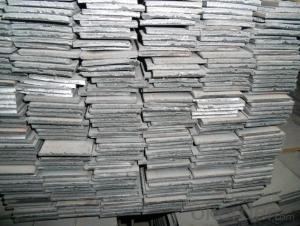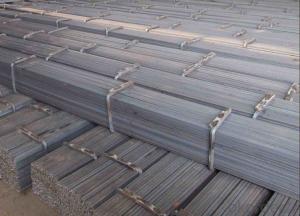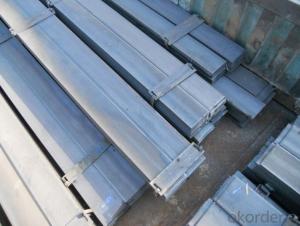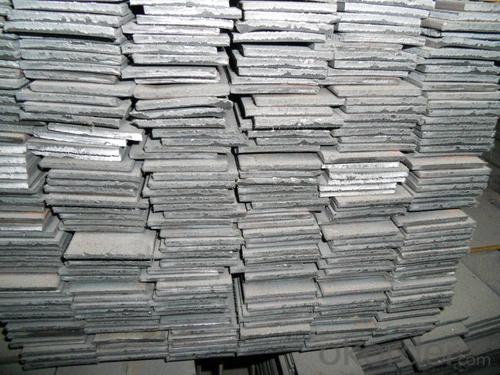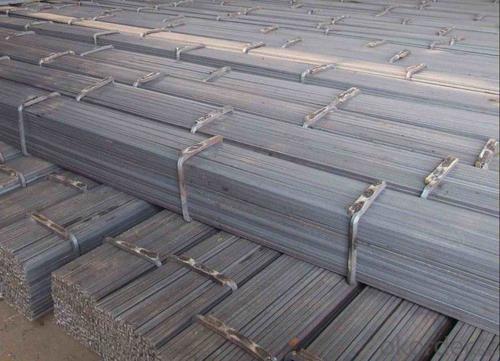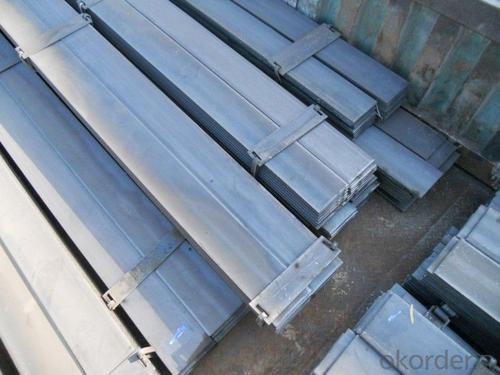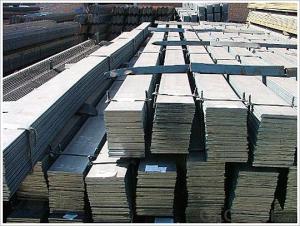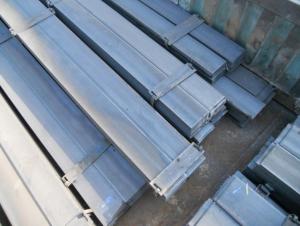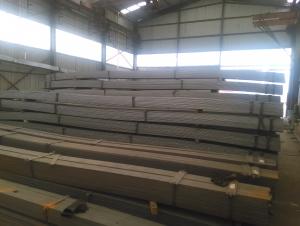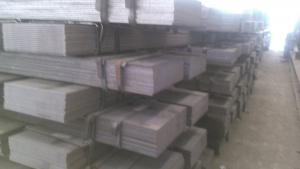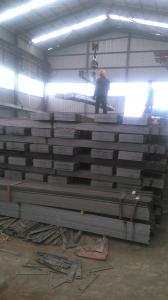Mild steel flat bars with high quality and low price
- Loading Port:
- Tianjin
- Payment Terms:
- TT OR LC
- Min Order Qty:
- 25 m.t.
- Supply Capability:
- 100000 m.t./month
OKorder Service Pledge
OKorder Financial Service
You Might Also Like
Mild Steel Flat Bar Details:
| Minimum Order Quantity: | 25 m.t. | Unit: | m.t. | Loading Port: | China Main Port |
| Supply Ability: | 80000-100000MTS/YEAR m.t./month | Payment Terms: | TT or LC |
Product Description:
Specification of Mild Steel Flat Bar
Commodity: Mild Steel Flat Bar
Standard: GB;JIS
Material: Q195-235;SS400
Brand name: FLATSPACE
Origin place: China
Thickness: 3mm-30mm
Width:20mm-200mm
Length: Max 12m
Certification: SGS/BV
Chemical composition of Q235
Alloy No | Grade | Element(%) | ||||
C
| Mn
| S
| P
| Si
| ||
Q235
|
B
|
0.12—0.20 |
0.3—0.7 |
≤0.045 |
≤0.045
|
≤0.3
|
Physical properties of Q235
Alloy No | Grade | Yielding strength point(Mpa) | Tensile strength (Mpa) | Elongation after fracture(%) | ||||||
Thickness (mm) | Thickness (mm) | |||||||||
≤16 | >16--40 | >40--60 | >60--100 | ≤16 | >16--40 | >40--60 | >60--100 | |||
≥ | ≥ | |||||||||
Q235 |
B |
235 |
225 |
215 |
205 |
375--500 |
26 |
25 |
24 |
23 |
Usage/Applications of Mild Steel Flat Bar
Widely used for construction, Machinery manufacturing, Iron tower steel structure, Shipbuilding; Steel grating, Staircase, Bridge, Viaduct, Railway spare parts, Boilers making etc.
Packaging & Delivery of Mild Steel Flat Bar
Packaging Details: The Mild Steel Flat Bars are packed in bundles and loaded in 20 feet/40 feet container, or shipped by bulk cargo ,also we can do as customer's requirements.
Delivery Details:30~45 days upon the receipt of buyer payment by T.T. or L/C.
Production Flow of Mild Steel Flat Bar
The Mild steel flat bar is made through three processes:
1.Feeding the material: Feeding the row material (the steel plate) to Slitting Line.
2.Slitting:The steel plate would be slitted into expected width by lengthways cutter.
3. Leveled and cutting: The plat bar would be ground into level by the grinder and then cut into required length.
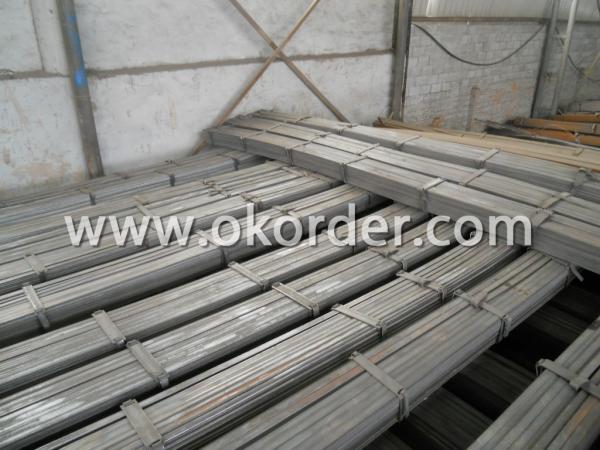
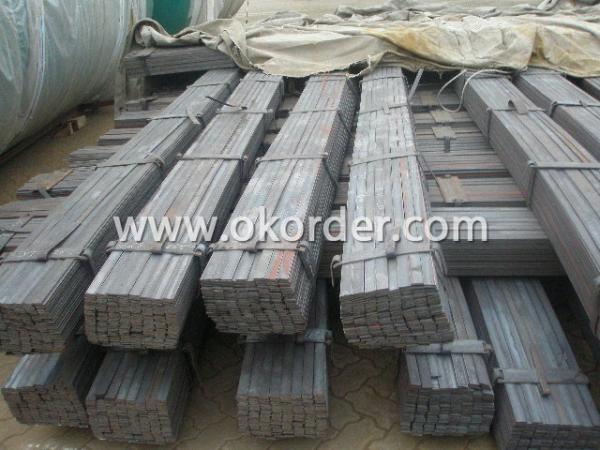

FLATSPACE is specialized in production and sales of slit flat bars. We offered the individuation processing service of slitting and crosscut. Our flat bar the width form 10mm to 1800mm, and thichness from 2.5mm to 25mm.
View Manufacturer's Shop
1. Manufacturer Overview | |
|---|---|
| Location | Hebei, China |
| Year Established | 2009 |
| Annual Output Value | Above US$ 150 Million |
| Main Markets | Southeast Aisa, Middle east, Africa |
| Company Certifications | |
2. Manufacturer Certificates | |
|---|---|
| a) Certification Name | |
| Range | |
| Reference | |
| Validity Period | |
3. Manufacturer Capability | |
|---|---|
| a)Trade Capacity | |
| Nearest Port | Tianjin |
| Export Percentage | 70%-80% |
| No.of Employees in Trade Department | 10-15 people |
| Language Spoken: | English; Chinese |
| b)Factory Information | |
| Factory Size: | Above 20,000 square meters |
| No. of Production Lines | 7 |
| Contract Manufacturing | OEM Service Offered; |
| Product Price Range | Average |
- Q: Can steel flat bars be used for making HVAC systems or components?
- Indeed, HVAC systems or components can be crafted using steel flat bars. Renowned for their robustness and endurance, steel flat bars are frequently employed in the construction sector. These bars can be utilized to manufacture a diverse array of HVAC system elements, including ductwork, brackets, supports, and frames. The flexibility of steel flat bars permits customization to meet precise design criteria. Furthermore, steel flat bars possess exceptional thermal conductivity, a valuable attribute for HVAC systems as it facilitates the efficient transfer of heat or cold air. In summary, steel flat bars are a fitting material option for the production of HVAC systems or components.
- Q: Is medium plate steel flat?
- Flat, refers to the width 12-300mm, thickness 4-60mm, cross section is rectangular in shape and with a blunt edge of steel. Flat steel can be finished steel, or can be used as the blank of welded pipe and thin slab for laminated sheet rolling. Main application: flat steel is used as a material, used for making iron, tools and machinery parts, and used as frame structures and escalators for buildings.
- Q: Can steel flat bars be used in the manufacturing of material handling equipment?
- Yes, steel flat bars can definitely be used in the manufacturing of material handling equipment. Steel flat bars, which are commonly made from carbon steel, are known for their strength, durability, and versatility. These qualities make them ideal for various applications in material handling equipment, such as constructing frames, supports, brackets, and other structural components. Steel flat bars can be easily welded, cut, and formed into different shapes and sizes, allowing for customization and flexibility in the manufacturing process. Additionally, steel flat bars have excellent load-bearing capabilities, making them suitable for handling heavy loads and providing stability and reliability in material handling equipment. Overall, steel flat bars are a popular choice in the manufacturing of material handling equipment due to their strength, durability, and ability to meet the demanding requirements of such equipment.
- Q: The grounding electrode 50 angle steel and the ground wire 50, the flat steel lap welding, according to the specification 169 needs the flat steel to be late 90 degrees, bends close to the angle steel side, the overlap width is 4 times (200mm)?
- Flat steel and steel, flat steel and angle steel, in order to reliable connection, should be in addition to the contact regions on both sides of the welding, and welding with arc steel should be bent into (or rectangular) clips or directly from the strip itself curved (or rectangular) and steel (or steel) welding.
- Q: Can steel flat bars be used for making brackets or supports for telecommunications towers?
- Yes, steel flat bars can be used for making brackets or supports for telecommunications towers. Steel is commonly used in the construction of telecommunications towers due to its strength, durability, and ability to withstand harsh weather conditions. Steel flat bars can be easily fabricated and customized to meet the specific requirements of the tower, providing reliable support and stability.
- Q: How do steel flat bars contribute to the overall stability of structures?
- Steel flat bars contribute to the overall stability of structures by providing structural support and resistance against bending and torsional forces. They are commonly used as beams, braces, and frames, helping to distribute the load evenly and prevent the structure from collapsing or deforming under various loads and external pressures. Their inherent strength, durability, and rigidity make them crucial components in reinforcing and enhancing the stability and integrity of different types of structures, including buildings, bridges, and industrial frameworks.
- Q: Can steel flat bars be used for fencing?
- Yes, steel flat bars can be used for fencing. They are commonly used as fence posts or horizontal rails in various types of fencing applications. Steel flat bars are durable, strong, and resistant to weathering, making them suitable for creating sturdy and long-lasting fences.
- Q: What are the different methods of surface hammering for steel flat bars?
- There are several methods of surface hammering for steel flat bars, each with its own unique characteristics and applications. These methods are used to create different textures and patterns on the surface of the bars, enhancing their aesthetic appeal and functionality. 1. Planishing: This technique involves using a planishing hammer or mallet to repeatedly strike the surface of the steel bar. The blows are carefully controlled and overlapping, resulting in a smooth, uniform texture. Planishing is commonly used to create a polished, reflective surface on steel bars, often seen in decorative applications. 2. Peening: Peening is a method where the steel bar is struck with a ball-peen hammer or a similar tool. The blows create a series of small indentations on the surface, giving it a textured appearance. This technique is often used to improve the grip or traction of steel bars, making them suitable for applications where slip resistance is essential. 3. Cross-peening: Cross-peening is a variation of peening where the hammer strikes the steel bar at an angle, creating a series of crossed indentations. This technique is typically employed to increase the strength and durability of the steel bar, as the cross-peened surface helps distribute stress more evenly. 4. Raising: Raising is a method used to shape steel flat bars into three-dimensional forms. It involves hammering the steel bar against a curved surface, such as a stake or an anvil, to gradually shape it into the desired contour. Raising can be used to create bowls, cups, or any other curved shapes from flat bars. 5. Chasing: Chasing is a technique where a pattern or design is hammered onto the surface of the steel bar using specialized chasing tools. The tools have different shapes and sizes, allowing for intricate and detailed designs to be created. Chasing is commonly used in ornamental metalwork to add decorative elements to steel flat bars. 6. Texturing: Texturing involves using various tools, such as a texturing hammer or stamp, to create a specific texture or pattern on the surface of steel bars. This method can be used to achieve a wide range of effects, from dimples and ridges to a hammered or brushed appearance. Texturing adds visual interest and can also improve the grip of the steel bars. Overall, these different methods of surface hammering for steel flat bars offer flexibility and versatility in terms of texture, pattern, and functionality. They allow for customization and innovation in various applications, from decorative metalwork to industrial and architectural uses.
- Q: What are the different methods of surface protection for steel flat bars in corrosive environments?
- There are several methods of surface protection for steel flat bars in corrosive environments. Some of the commonly used methods include: 1. Galvanization: This process involves coating the steel flat bars with a layer of zinc. The zinc acts as a sacrificial anode, protecting the steel from corrosion. Galvanization can be done through hot-dip galvanizing, where the bars are immersed in a bath of molten zinc, or through electroplating, which involves the application of zinc using an electric current. 2. Powder coating: Powder coating involves applying a dry powder onto the surface of the steel flat bars. The powder is then heated and cured, forming a protective layer. Powder coating provides excellent corrosion resistance and can be customized in terms of color and finish. 3. Paint or epoxy coating: Applying a layer of paint or epoxy coating can effectively protect steel flat bars from corrosion. These coatings act as a barrier between the metal and the corrosive environment, preventing moisture and chemicals from reaching the surface of the steel. 4. Stainless steel cladding: In this method, a layer of stainless steel is bonded to the surface of the steel flat bars. Stainless steel is highly resistant to corrosion, making it an effective protective layer against corrosive environments. 5. Organic coatings: Organic coatings, such as polyurethane or acrylic coatings, can be applied to steel flat bars to provide corrosion protection. These coatings create a barrier that prevents moisture and corrosive agents from reaching the steel surface. 6. Metal plating: Steel flat bars can be plated with metals such as nickel or chrome to enhance their corrosion resistance. The plating process involves immersing the bars in a solution containing the metal ions, which then adhere to the surface of the steel. It is important to consider the specific requirements of the corrosive environment and the expected lifespan of the steel flat bars when selecting a surface protection method. Each method has its own advantages and limitations, so choosing the most suitable option will depend on factors such as cost, durability, and the severity of the corrosive environment.
- Q: Can steel flat bars be used for toolmaking?
- Yes, steel flat bars can be used for toolmaking. Steel is a versatile and durable material that is commonly used in toolmaking due to its strength and resistance to wear and tear. Steel flat bars can be easily shaped and machined to create various types of tools such as punches, chisels, and cutting blades. Additionally, steel can be heat-treated to increase its hardness and toughness, making it suitable for applications that require high strength and precision. Overall, steel flat bars are a popular choice for toolmaking due to their excellent mechanical properties and versatility.
Send your message to us
Mild steel flat bars with high quality and low price
- Loading Port:
- Tianjin
- Payment Terms:
- TT OR LC
- Min Order Qty:
- 25 m.t.
- Supply Capability:
- 100000 m.t./month
OKorder Service Pledge
OKorder Financial Service
Similar products
Hot products
Hot Searches
Related keywords
